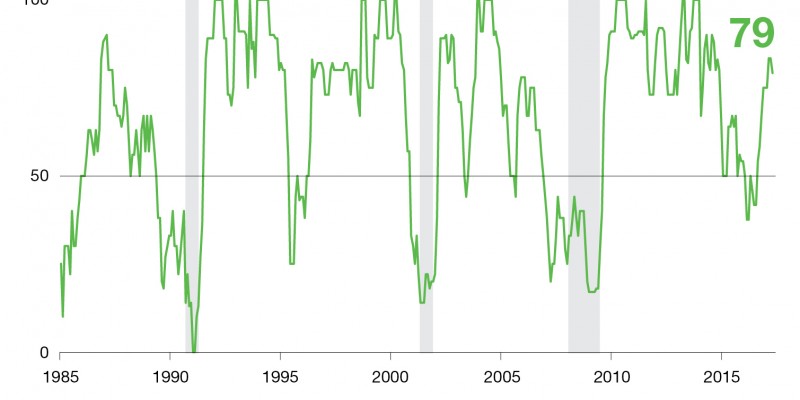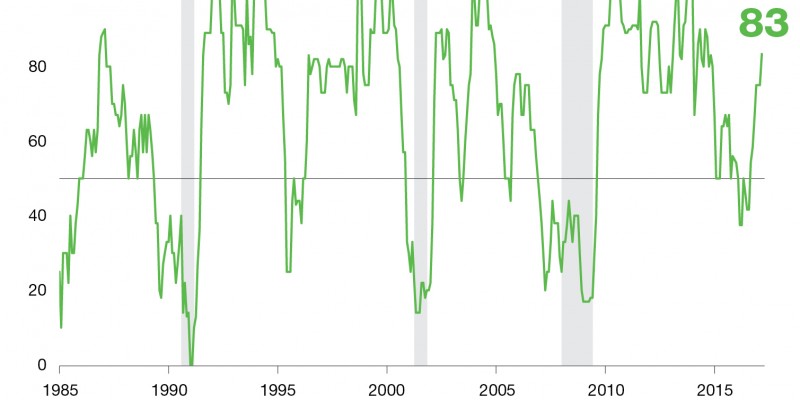Existing-home sales rose a modest 1.1 percent in May, held back by a tight supply of available existing homes for sale. Compared to a year ago, existing-home sales were up 2.7 percent. The inventory of homes for sale rose 2.1 percent to 1.96 million, p …
READ MORE
The AIER Business-Cycle Conditions Leaders index fell slightly to 79 in May, the first decline since July 2016. The Coinciders index remained at a perfect 100 for a third month, while the Laggers index held at 75 for the second month. All three indexes …
READ MOREThe Fed raised the target range for the federal funds rate by a quarter point yesterday to 1.0 − 1.25 percent, the fourth rate increase in the current business cycle and the second increase of 2017. The Fed also updated its Summary Economic Projections …
READ MOREOn the day the Federal Reserve is expected to raise the target for the federal funds rate for the second time this year, key economic reports have posted declines showing broad weakness. Retail sales and the Consumer Price Index fell 0.3 percent and 0.1 percent, respectively, suggesting that despite a strong labor market and monetary policy that is still extraordinarily supportive, neither economic growth nor consumer price increases are accelerating sharply.
READ MOREThe Bureau of Labor Statistics reported that the number of open jobs in the United States topped 6 million for the first time. The total number of open jobs hit 6.044 million in April, pushing the openings rate (the number of open jobs divided by emplo …
READ MORETwo reports from Institute for Supply Management both point to similar conclusions. The “Manufacturing Report on Business” and the “Non-Manufacturing Report on Business” both suggest economic activity continues to grow at a moderate pace, employment is …
READ MORE
The Employment Situation report from the Bureau of Labor Statistics, known as the jobs report, was weaker than expected for May. Nonfarm payrolls added just 138,000 new jobs for the month, below the consensus expectations of 178,000. Excluding the loss of 9,000 workers from government payrolls, the private sector added just 147,000 for May. That is well below the average of 179,000 new jobs added per month over the past year. The slowdown in job creation was widespread across most industries. There are two competing theories on the cause of the slowdown: the United States is running out of workers, or the economy is slowing down. Those two explanations have dramatically different implications for the economic outlook.
READ MORE
The ADP National Employment Report shows U.S. businesses added 253,000 workers in May. That result follows a revised 174,000 gain in April and makes May the sixth month in the past seven when private payrolls increased by more than 200,000. The ADP figures may not match the data from the national employment report from the Bureau of Labor Statistics each month (due out Friday, June 2), but the trends tend to be similar.
READ MORE
Revisions to first quarter real GDP show the economy expanded at a 1.2 percent annual rate compared to the initial estimate of 0.7 percent. The major contributors to the upward revision were consumer spending, business investment, and government.
READ MORE
The Chicago Fed’s National Activity Index, a weighted average of 85 economic indicators, rose to 0.49 in April following a 0.07 reading in March. For this index, zero represents trend growth in the economy with positive numbers suggesting above-trend growth and negative numbers implying below-trend growth. Using a six-month moving average to smooth out the monthly volatility, the index registered 0.14 in April, the highest since December 2014 and well above the −0.24 result in May and August 2016.
READ MORE
Economic data over the past month show mostly favorable underlying trends. The labor market remains the cornerstone of the expansion, with job creation and wage gains boosting aggregate personal income. Consumer spending continues to trend higher with …
READ MORE
Industrial production jumped 1.0 percent in April, the largest monthly gain since February 2014. Over the past year, industrial production is up 2.2 percent, the best growth since the year ending in January 2015. Those gains helped push capacity utilization up 0.6 percentage points to 76.7, the highest since August 2015.
READ MORE250 Division Street | PO Box 1000
Great Barrington, MA 01230-1000
Press and other media outlets contact
888-528-1216
press@aier.org
This work is licensed under a
Creative Commons Attribution 4.0 International License,
except where copyright is otherwise reserved.
© 2021 American Institute for Economic Research
Privacy Policy
AIER is a 501(c)(3) Nonprofit
registered in the US under EIN: 04-2121305